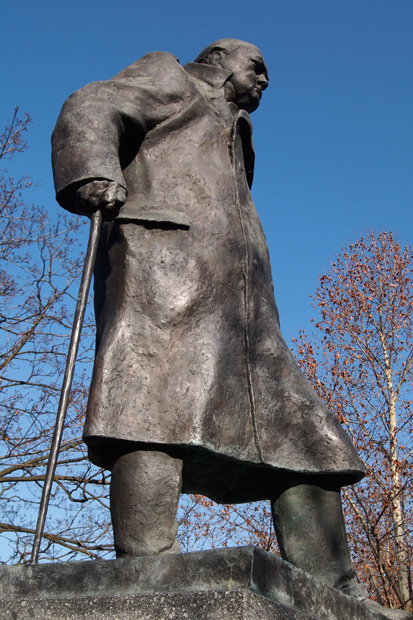Ivor Roberts-Jones was in many ways the right artist at the wrong time. Had the sculptor been born a few decades earlier and worked in the Victorian age, when statues of the builders and defenders of empire were erected proudly and prolifically across the land, he’d surely have received no end of garlands. As it is, Roberts-Jones (1913–96) found himself constantly battling against artistic fashions and today is barely even talked about.
Born in the Welsh border town of Oswestry, he moved to London to study at the Royal Academy Schools and Goldsmiths College (the latter’s fame as a breeding ground for conceptual excess still a long way into the future). A fledgling career had barely got going before war broke out and Roberts-Jones was posted to India and then Burma, where he served with the Royal Artillery.
His sculptural style was rooted in realism, his hero Rodin; yet, returning to post-war Britain, Roberts-Jones found the vogue was for nuanced figuration straining towards abstraction. The Tate director Sir John Rothenstein recognised — in the likes of Lynn Chadwick, Eduardo Paolozzi and Bernard Meadows —a gifted new generation of British sculptors. Roberts-Jones, in contrast, was dedicated to figurative work and in 1953 founded the (still-active) Society of Portrait Sculptors.
Perhaps his best pieces were the portrait heads he made of friends and family, capturing the subtleties and quirks of sitters he knew well. Yet his fame rests largely on his full-length public sculptures, vast memorials to the likes of Rupert Brooke, Augustus John, and, on Whitehall, the veteran Field Marshals Viscount Slim and Alanbrooke.
In their new book — a monograph, complete with catalogue raisonné— Jonathan Black and Sara Ayres dub Roberts-Jones ‘the last icon-maker’, and they do a good job setting his career in the context of lifelong charges of antediluvianism. We also learn of his frequent battles, where public commissions were concerned, with bureaucracy and cronyism.
Nowhere was this starker than with his statue of Churchill for Parliament Square, by far his most famous work and arguably the last grand commemoration of its kind. The dispute was endless as to what form the tribute should take, much of it fought out in the letters pages of the Telegraph and Times, so moody, multi-faceted and monumental a chap had Britain’s wartime leader been.
Retreating to his barn in Suffolk — following various false starts from the Winston Churchill Memorial Committee (and its statue adjudication sub-committee) — Roberts-Jones began work on a bronze figure 12ft tall. Surviving two years hauling himself up and down ladders — not to mention the cold freezing his clay in winter, further committee interruptions and the unexpected intrusion of a passing bull — the result was finally unveiled by Lady Spencer-Churchill in 1973. While some observers were impressed, others felt the depiction of a doddery Churchill propped up by a walking stick was unbecoming. Looking back in later life, Roberts-Jones referred to the whole commission as a ‘most unpleasant business’.
He also spent many years teaching, though he realised sculpture had changed out of all recognition when one student exhibited a hole in the ground as part of his degree show. Not long before his death, he was swiping at the ‘shed-destroyers’ and ‘sheep-slayers’ (Cornelia Parker and Damien Hirst), but few were now listening to him.
The book is strong on the technical aspects of Roberts-Jones’s career, but what it lacks is any personal or psychological insight. Beyond the mention of occasional ‘wobbles’, during which he contemplated giving up sculpture altogether, we get nothing of his internal demons. Which is a pity because, however dated his sculptures, the struggle of a solitary artist out of step with world around him is forever fascinating.
Available from the Spectator Bookshop, £22.50. Tel: 08430 600033. Alastair Smart is arts editor and chief art critic of the Sunday Telegraph.






Comments